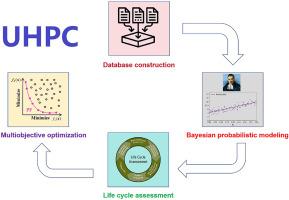数据驱动的高性能混凝土抗压强度估算与配合比优化
IF 7.4
2区 工程技术
Q1 CONSTRUCTION & BUILDING TECHNOLOGY
引用次数: 0
摘要
超高性能混凝土(UHPC)由于其优异的机械强度和长期耐久性,在包括摩天大楼、桥梁和地下设施在内的关键基础设施项目中得到了广泛的应用。然而,它的广泛采用受到性能变化、高生产成本和大量碳排放的限制。为了克服这些问题,本研究开发了一个统一的框架,将贝叶斯模型更新、生命周期评估(LCA)和蚁群优化(ACO)相结合,预测UHPC的力学性能和可持续性性能,并优化混合比例。利用102组压缩试验数据,建立了物理可解释、高精度的强度预测模型,确定了水胶比、硅胶比、砂胶比、纤维体积分数和高效减水剂用量为关键因素。然后,LCA模型量化了这些变量如何影响强度等效UHPC的碳足迹和成本。蚁群算法可实现双目标和三目标混合优化。主要发现包括:(i)降低水胶比和砂胶比,同时增加硅灰、纤维和高效减水剂的含量,可以提高强度,其中前两个因素的影响最大。(ii)贝叶斯模型在准确性、稳健性和可解释性方面优于传统的线性模型。在相同强度下,增加砂到粘合剂的比例可以降低成本和排放量;改变二氧化硅烟胶比对成本影响较小,但显著降低了排放;高纤维或高效减水剂可提高两者的含量。(iv)该框架可减少高达50%的碳足迹和成本,并最大限度地减少抗压强度低于185mpa的纤维使用。本文章由计算机程序翻译,如有差异,请以英文原文为准。

Data-driven compressive strength estimation and mix optimization for ultra-high-performance concrete
Ultra-high-performance concrete (UHPC) has found wide application in key infrastructure projects, including skyscrapers, bridges and subsurface facilities, owing to its outstanding mechanical strength and long-term durability. Its broader adoption, however, is limited by performance variability, high production costs and substantial carbon emissions. To overcome these issues, this research develops a unified framework that integrates Bayesian model updating, life cycle assessment (LCA) and ant colony optimization (ACO) to predict UHPC's mechanical and sustainability performance and optimize mix proportions. Using 102 sets of compressive test data, a physically interpretable and highly accurate strength prediction model was developed, identifying the water-to-binder ratio, silica-to-binder ratio, sand-to-binder ratio, fiber volume fraction and superplasticizer dosage as key factors. An LCA model then quantified how these variables influence the carbon footprint and cost of strength-equivalent UHPC. The ACO algorithm enabled both bi- and tri-objective mix optimization. Key findings include: (i) Reducing water-to-binder and sand-to-binder ratios while increasing silica fume, fiber and superplasticizer contents enhances strength, with the first two factors having the greatest impact. (ii) The Bayesian model surpasses traditional linear models in accuracy, robustness and interpretability. (iii) At equal strength, increasing sand-to-binder lowers cost and emissions; altering silica fume–to–binder ratio slightly affects cost while notably reducing emissions; higher fiber or superplasticizer increases both. (iv) The framework achieves up to 50 % reductions in carbon footprint and cost, and minimizes fiber use for compressive strengths below 185 MPa.
求助全文
通过发布文献求助,成功后即可免费获取论文全文。
去求助
来源期刊

Journal of building engineering
Engineering-Civil and Structural Engineering
CiteScore
10.00
自引率
12.50%
发文量
1901
审稿时长
35 days
期刊介绍:
The Journal of Building Engineering is an interdisciplinary journal that covers all aspects of science and technology concerned with the whole life cycle of the built environment; from the design phase through to construction, operation, performance, maintenance and its deterioration.
 求助内容:
求助内容: 应助结果提醒方式:
应助结果提醒方式:


